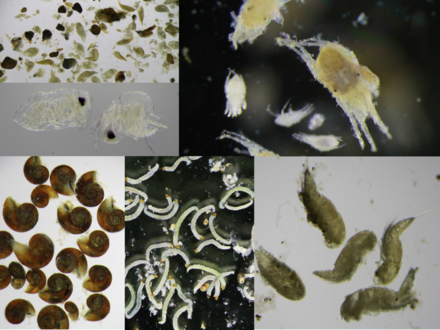Náttúrulegur breytileiki í vistnýtingu þorsk- og ufsaseiða - verkefni lokið
Fréttatilkynning verkefnisstjóra
Rannsóknir á ungviði Atlantshafsþorsks (Gadus morhua) og ufsa (Pollachius virens) benda til lykilhlutverks búsvæða í strandsjó sem uppeldissvæði. Þrátt fyrir þetta mikilvægi er lítill skilningur á búsvæði og auðlindanýtingu fiskungviðis á Íslandi. Samsvæða nýting búsvæða seiða af mismunandi tegundum og stærðarflokkum getur leitt til samkeppni um nýtingu og breytinga á búsvæðavali, fæðuauðlindum og stærð bráðar.
Þessi rannsókn hafði það að markmiði að auka þekkingu og skilning á dreifingu, fæðuvist og breytileika milli einstaklinga þorsks og ufsa á uppeldisstöðvum. Greiningar á magainnihaldi og stöðugum efnasamsætum voru notaðar til að kanna fæðuvist, skörun fæðu og sérhæfingu einstaklinga í fæðunámi. Merkingar með hljóðmerkjum voru notaðar til að skýra dreifingu, vistnýtingu og hegðun seiðanna í náttúrunni. Niðurstöður rannsóknarinnar koma að gangi við að skilja þá vistfræðilegu og umhverfislegu ferla sem hafa áhrif á vöxt, lifun og nýliðun í fiskistofna og auka möguleika á skipulagi og vernd uppeldisstöðva fiskungviðis á Íslandi.
English:
Studies on juvenile Atlantic cod (Gadus morhua) and saithe (Pollachius virens) suggest a key role for structured habitats in marine coastal waters as nursery grounds. Despite this importance, habitat and resource use of juvenile fish in Iceland is poorly understood. The coexistence of juveniles of different species and size classes can lead to competition for resource exploitation and, in turn, changes in habitat choice, feeding resources, and prey size. This study aimed to provide much needed knowledge and understanding about the spatial and vertical distribution, trophic niche and variation between individuals during the settlement of juvenile gadoids, specifically Atlantic cod migratory and resident ecotypes and saithe. Specifically, stomach content analysis and stable isotope analysis was used to examine the trophic niche, diet overlap and individual diet specialisation of Atlantic cod ecotypes and saithe across ontogeny. Acoustic telemetry was used to elucidate distribution, dispersal and movement behavior of Atlantic cod ecotypes and saithe in the wild. Results from the proposed study are fundamental to understand further processes influencing growth, survival and year-class recruitment of fishes and have a great potential to facilitate the management of juvenile nursery grounds in Iceland.
Information on how the results will be applied
Results of this study highlight the great importance of nearshore nursery grounds for Iceland´s economically most important fish species. This information is a strong argument toward the conservation of coastal habitats, and could lead, for example, the establishment of coastal marine protected areas in Iceland and stricter rules for nearshore industries, both, on land and in water. Furthermore, results of this study will be available to the public through open access journals and presented on scientific conferences. To better facilitate communication with a wider audience, the study results will be presented on public science talks at universities and schools.
∙ A list of the project’s outputs
Conference talks:
∙ Anja Nickel, Guðbjörg Ásta Ólafsdóttir, May, 2022, oral presentation on Spatial Ecology of Sympatric Juvenile Atlantic Cod and Saithe at Nursery Grounds, EcoIce, Reykjavík
∙ Anja Nickel, Guðbjörg Ásta Ólafsdóttir, October 2021, poster presentation on Spatial overlap between two ecologically Similar gadoid species at nursery grounds, IceBio, Reykjavík
∙ Anja Nickel, Guðbjörg Ásta Ólafsdóttir, March 2020, oral presentation on Primary carbon sources in the coastal fish assemblage of Breiðafjörður, OIKOS, Reykjavík
∙ Anja Nickel, Guðbjörg Ásta Ólafsdóttir, September 2019, oral presentation on Primary carbon sources in the coastal fish assemblage of Breiðafjörður, IceBio, Reykjavík virtual
Publications in progress:
1. Distribution and trophic niche of juvenile Atlantic cod and saithe across ontogeny
2. Trophic and spatial ecology of juvenile Atlantic cod and saithe at nearshore nurseries
3. Bridging individual fish activity identified in laboratory experiments with movement measured in the wild in juvenile Atlantic cod

Surgical implantation of an acoustic transmitter on an anaesthetized juvenile saithe: A) Cut in the fish abdomen, B) Insert of the transmitter, C) Closure of incision with suture, D) Finish suture with knot; pictures: Halldór Sveinbjörnsson

Prey items found in stomachs of 0-group Atlantic cod and saithe
Heiti verkefnis: Náttúrulegur
breytileiki í vistnýtingu þorsk- og ufsaseiða / Variation in resources use in
juvenile Atlantic cod and saithe under natural conditions
Verkefnisstjóri: Anja Katrin Nickel, Háskóla Íslands
Tegund styrks: Doktorsnemastyrkur
Styrktímabil: 2019-2021
Fjárhæð styrks kr. 20.126.000
Tilvísunarnúmer Rannís: 196133


